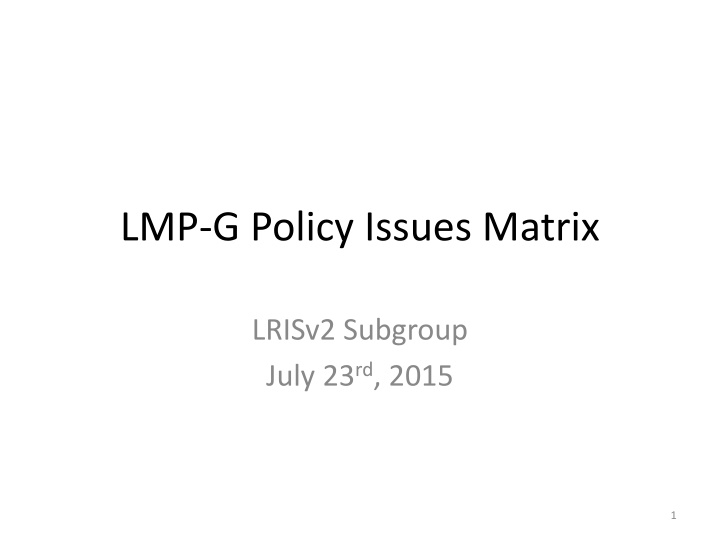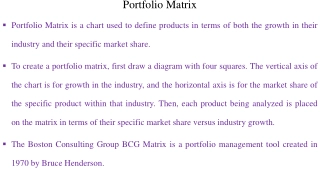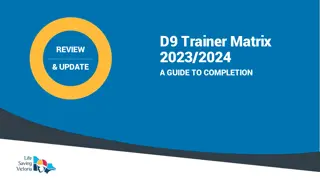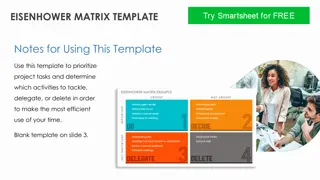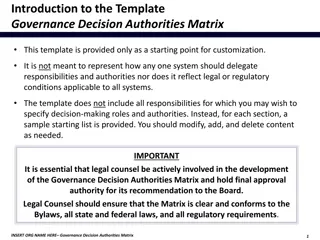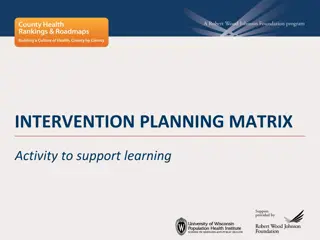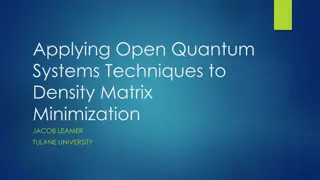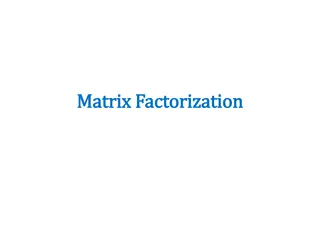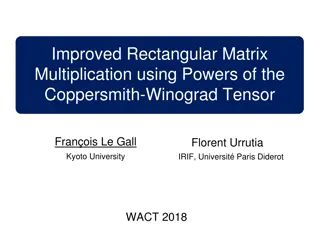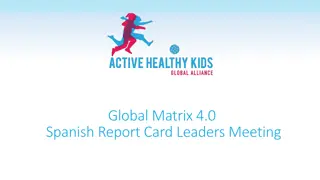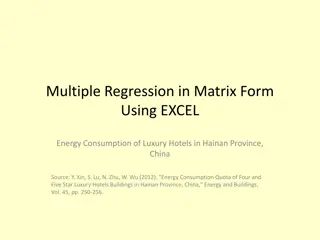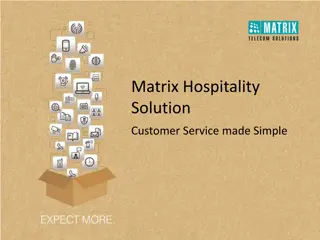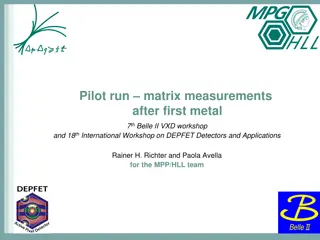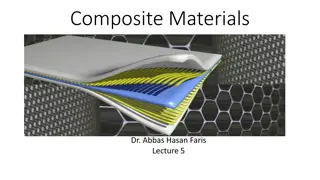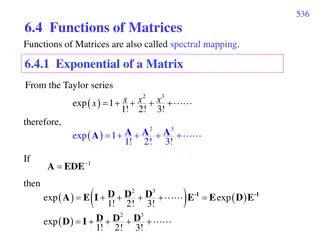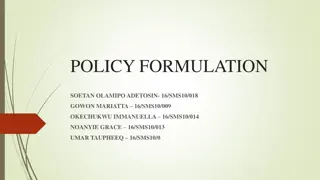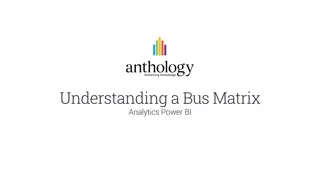LMP-G Policy Issues Matrix
The LMP-G Policy Issues Matrix LRISv2 Subgroup discusses various policy issues related to Load Management Performance minus Generation, including concerns about financial benefits, customer incentives, ERCOT settlements, rules for LSEs/REPs and DR QSEs, market policies for wholesale price formation, and implementation considerations for new market structures.
Download Presentation

Please find below an Image/Link to download the presentation.
The content on the website is provided AS IS for your information and personal use only. It may not be sold, licensed, or shared on other websites without obtaining consent from the author.If you encounter any issues during the download, it is possible that the publisher has removed the file from their server.
You are allowed to download the files provided on this website for personal or commercial use, subject to the condition that they are used lawfully. All files are the property of their respective owners.
The content on the website is provided AS IS for your information and personal use only. It may not be sold, licensed, or shared on other websites without obtaining consent from the author.
E N D
Presentation Transcript
LMP-G Policy Issues Matrix LRISv2 Subgroup July 23rd, 2015 1
TAC Motion on LMP-G On Oct 6th, 2011, TAC voted to affirm the WMS recommendation for the further development of the LMP minus G option 2
LMP-G Policy Issues Matrix Policy Issue Comment The principle of LMP-G asserts that Load should not receive financial benefit more than once for providing demand response (i.e. double payments). Consensus LMP-G cannot be enforced at the customer level. Rather, incentives should be provided at the wholesale market level with the understanding that competitive retail market forces will cause the incentives to trickle down to customers and fulfill the principle of LMP-G. Consensus Neither Bid-to-Buy, LMP-VG nor LMP-Proxy $G can guarantee that every DR customer will not receive double payments. Consensus 3
LMP-G Policy Issues Matrix Policy Issue Comment ERCOT can settle an LSE/REP QSE for energy not consumed and pay a Proxy $G value for that energy (UFE and T&D Loss methodologies may be precedent). Consensus; may require PUCT Action LSE/REP cannot bill a customer for energy not consumed without changes to PURA or PUCT Substantive Rules. Requires Leg/PUCT Action Rules must be established to track customer switches, rectify inadvertent switches, and notify both REP of Record and DR QSE. Requires PUCT Action REPs must have ability to charge an early termination fee if customer switches to DR QSE. Requires PUCT Action Rules must be established to define what will happen to a customer s rate plan when customer joins a DR QSE, if the current retail service plan with the REP includes an incentive tied to DR capability. Requires PUCT Action 4
LMP-G Policy Issues Matrix Policy Issue Comment LSEs/REPs and DR QSEs should operate with comparable, equitable, and reasonable rules. Consensus Rules must be established to detail the mechanics of switch administration. PUCT Rules must be established to govern customer engagement and recruitment. PUCT Rules must be established to define consumer protection, including right of rescission and privacy of proprietary customer information. PUCT Rules must be established to track, validate, and contest (if erroneous) customer switching (e.g. from a REP DR program to a 3rd Party). PUCT Rules must be established to define requirements and information disclosures to residential and small commercial customers (similar to Electricity Facts Label). PUCT 5
LMP-G Policy Issues Matrix Policy Issue Comment ERCOT Stakeholders should strive to implement market policies which allow loads to contribute to wholesale price formation via active participation in the Real Time Market. Consensus Implementation of new market uplifts should be minimized. Consensus The existing ORDC and Loads in SCED bid to buy market structures should be preserved. Consensus Cost of implementation should be weighed against potential participation and market benefits. Consensus LMP-Volumetric G should be implemented simultaneously with LMP- Proxy $G. (Prioritizing Proxy $G implies preference for enabling residential participation over C&I). No Consensus Rules need to be established to ensure DR QSEs are not participating with the same customers, similar to how switching rules prohibit REPs from participating with the same customers. Consensus 6
Following slides were not considered at 7/23 Subgroup meeting. 7
LMP-G Policy Issues Matrix Policy Issue Comment Certain retail rates should disqualify a customer from participation in a DR QSE ALR. No Consensus A mechanism will need to be designed to enforce retail rate disqualification. No Consensus A default rate must be established that a REP will move a customer to if their rate is inconsistent with Proxy $G and they signed up with a DR QSE. No Consensus The value of Proxy $G should be determined using the POLR rate structure. No Consensus 8
LMP-G Policy Issues Matrix Policy Issue Comment A DR Provider should become a new type of ERCOT Market Participant. Consensus? Customers should have a DR Provider of Record (DRPOR), similar to REP of Record. Consensus? Rules must be adopted to prevent DR-blocker strategies by REPs and REP offer blocker strategies by DR QSEs. PUCT Rules must be established to resolve competing claims for DRPOR. PUCT A LSE/REP can be a DRPOR for another LSEs/REPs customers. No Consensus Rules must be established to manage DR QSE ALRs which contain customers from numerous LSEs/REPs, including maintaining minimum LSE/REP portfolio sizes within ALRs Consensus A LSE/REP DRPOR (serves 100% of its ALR Load) should have the option of participating with either an Offer to Sell or a Bid to Buy. No Consensus 9
LMP-G Policy Issues Matrix Policy Issue Comment TX SET is optimal mechanism for high volumes of DR-related market transactions and notifications Consensus TX SET transactions/notifications should include: Request to enroll a customer with a DRPOR Enrollment request response (accepted/rejected) DRPOR request to discontinue a customer enrollment (and response) Notifying LSE/REP that its customer has enrolled with a DRPOR Notifying LSE/REP that its customer has discontinued enrollment with a DRPOR Notifying DRPOR that its customer has switched REPs Notifying DRPOR that its customer has had a profile change (e.g. from RES to BUS, BUS to RES), meter type change (IDR to NIDR), Load Zone change, status change (de-energized/inactive) Others No Consensus A TX SET solution should be contingent upon a MW participation trigger. Consensus? 10
LMP-G Policy Issues Matrix Policy Issue Comment DR Providers should be afforded protection against stranded cost issues for DR devices. No Consensus Rules need to be established to manage snapback effect issues. Potential for DR QSEs to shift costs onto LSEs/REPs; or could have large effect on DR QSEs, either in paying for it or designing strategies to minimize it. Consensus DR QSEs should wear snapback risk and be charged for snapback effect No Consensus DR QSEs must obtain permission from a NOIE to solicit customers for Loads in SCED participation in NOIE territories. Consensus DR QSE ALRs can combine customers from NOIE and competitive territories so long as minimum portfolio threshold is met and the customers are all within a single Load Zone. Consensus 11
